
JAZZ at M c CARTER



JAZZ at M c CARTER


In keeping with our mission to present, promote and preserve jazz, NJJS launched its Juried Scholarship Competition in 2022— which awards a $1,000 first prize, and a $500 second prize, in each of two categories: Jazz Performance and Original Composition. The competition is open to New Jersey college students currently enrolled in a a college undergraduate music program, as well as to New Jersey residents currently enrolled an out of state college undergraduate music program.
It’s with great delight that I share the news that this year’s Competition produced 14 student submissions—seven Jazz Performance applicants and seven Jazz Composition applicants. Judged by professional musicians, educators and industry leaders comprised of: Don Braden—world class tenor saxo-
phonist, flutist, composer and educator
Ted Chubb—Vice President, Jazz Education + Partnerships Associate Producer, Jazz House Kids, trumpeter, composer, and educator
Jason Olaine—Vice President of Programming, Jazz at Lincoln Center
Mariel Bildsten—Trombonist, bandleader, sidewoman, and educator
The submissions are currently being assessed, and the winners will be announced in June and profiled in a future issue of Jersey Jazz. We’re very grateful to Don, Ted, Mariel and Jason for their participation and expertise, and continue to seek their advice as we grow this competition.
The Board and I would like to thank Nan Hughes Poole and NJJS Board Member Cynthia Feketie for their generous support of this initiative. NJJS would also like to thank the New Jersey college educators who
championed this initiative, and encouraged their students to participate.
If you’d like to support this initiative, and help grow the prizes, you can do so with a credit card donation easily facilitated on our website njjs.org please note “Scholarship Competition” when processing your gift, or by check: NJJS, 382 Springfield Ave, Ste. 217, Summit NJ, 07901, and note “Scholarship Competition” in the Memo. Please feel free to contact me via email pres@njjs.org or phone: 973.229.0543 if you have any further questions.
We look forward to seeing you Sunday, May 5th at 3:00 p.m., for Jersey Jazz LIVE!—or more aptly titled the “Trombone Summit .” This concert will feature trombonist Mariel Bildsten and her quartet along with showcasing trombonist Ming-Lang Qin
as the Rising Stars opening act.
Described as “irrepressibly spontaneous” by DownBeat Magazine, Mariel performs regularly in NYC, headlines jazz festivals nationally and internationally, is a passionate educator, and has shared the stage with contemporary greats—Jon Batiste being one of them. Bandleader and side-woman, Bildsten is equally adept at playing in big bands, small groups, as well as Afro-Latin music, rock, funk, and R&B bands. This afternoon of music should prove quite lively and entertaining.
The Rising Stars initiative— showcasing young musicians—has been met with much enthusiasm and reaffirms that jazz is alive and well, and thriving in the hands of the next generation of musicians.
For more detailed information on these fine musicians, please see page 10.
Admission is $10 members / $15 non-members. Tickets are available online at: madisonarts.ticketleap. com/njjs-bildsten-05-05-24/
Tickets will also be available at the door. Doors open at 2:30 p.m., concert starts at 3:00 p.m.. Light refreshments for purchase. Free street parking is available. Madison Community Arts Center, 10 Kings Road, Madison, NJ.
Save the dates for the following future LIVE! events: June 9—Forbidden Tropics/Afro Peruvian Jazz; October 6—A screening of the documentary Jimmy Van Heusen: Swingin’ With Frank & Bing along with live music, Q&A, and commentary from Director Jim Burns; November 3—2024 Scholarship Winners Showcase with industry professionals; and December 8—TBD/NJJS Annual Meeting. Plan ahead and plan on joining us!
Perhaps you’d like to sponsor or co-sponsor a Jersey Jazz LIVE! event? Funding for the Jersey
Jazz LIVE! events has been made
possible, in part, by funds from Morris Arts though the New Jersey State Council on the Arts/ Department of State, a partner agency of the National Endowment for the Arts. This program is also proudly supported by a grant from The Summit Foundation.
While we’re very grateful for this support, this funding doesn’t cover the full costs of our programming. If you or someone you know would like to sponsor or co-sponsor one of these programs, please contact me at pres@njjs.org or at 973.229.0543 for more information.
I’d like to take this opportunity to congratulate Brett Messenger—currently the Curatorial
Director of Live Arts at the Morris Museum—on his exciting new position as Executive Director of Gettysburg College’s Majestic Theater.
Five and a half years ago, I met with Brett in the hopes that he would support the longstanding partnership between the Museum and NJJS, and continue the tradition of jazz programming at the Bickford Theater. In that meeting, he confessed to knowing “nothing about jazz.” Well, he proved a fast study and indeed championed jazz programming! Quick to get jazz musicians back to work once the pandemic restrictions were lifted, he created the Jazz on the Back Deck Series—which if you haven’t attended you’re missing out on great music and lots of fun—providing at the time, work and community in a safe and enjoyable environment. And I’m very happy to announce
that the Back Deck Series—both jazz and classical programming— will go on as scheduled this year.
This new position in Gettysburg is a marvelous opportunity for Brett and I know he’ll take his love for live arts—and new passion for jazz—to bear on this facility.
While I’m personally heartbroken to see my dear friend leave the Morris Museum/Bickford Theater behind, please join me in congratulating him on this new appointment and thanking him sincerely for the great support he has shown for jazz programming at the Bickford.
NJJS has a longstanding relationship with the museum, and we look forward to continuing our support of jazz programming under Brett’s successor.
“Music can change the world because it can change people.” Bono

SUNDAY, MAY 5 3:00 PM Madison Community Arts Center
10 KINGS ROAD, MADISON, NJ FREE STREET PARKING ON KINGS ROAD
$ 10 MEMBERS | $ 15 NON-MEMBERS
$ 5 STUDENTS (WITH VALID I.D.)


April was Jazz Appreciation Month, and there was a lot to appreciate. For starters, on April 11, I attended the Senior Recital of keyboardist Leonieke Scheuble, who is graduating from William Paterson University. I first saw Scheuble play about nine years ago when she was 13 and have seen her many times since. Particularly memorable, however, was a performance in August 2019 at the Jazz Arts Project’s Jazz in the Park series in Red Bank. She was 17, leading a quintet of veteran musicians: her father, Nick, on drums; Bill Crow on bass; Joe Magnarelli on trumpet; and Adam Brenner on tenor saxophone. Despite her young age, she was clearly in charge. The band played a variety of hard bop classics such as Bobby Timmons’ “Dat Dere” and “Moanin’”, Horace Silver’s “Senor Blues”,
and Nat Adderley’s “Worksong”. After that concert, Scheuble told me, “Music has always been in our house. I grew up hearing (Lee Morgan’s) ‘Sidewinder’, Art Blakey and the Jazz Messengers, and Clifford Brown. Hard bop has a blues aspect, and I’ve always gravitated toward tunes that are bluesy.”
So, it was no surprise that Scheuble led off her recital with “Moanin’.”
Other selections included her own composition, “2:52 a.m.”, named that because she does her best composing in the middle of the night; Duke Ellington’s “In a Sentimental Mood” and Arthur Schwartz’s “You and the Night and the Music”. She was accompanied by trumpeter Vinnie Cutro, tenor saxophonist Bob Hanlon, bassists Crow and Tim Givens, and her father on drums. The concert concluded with her arrangement of Lalo Schifrin’s “The Cat”,
accompanied by the William Paterson Jazz Orchestra, which included trombonist Richard LeRouech, a 2023 NJ Jazz Society scholarship winner (who had his own Senior Recital on April 20) and freshman trumpeter Violet Mujica, who led a Rising Stars opening act at the October 2023 NJJS Jersey Jazz LIVE! concert in Madison.
On Sunday, April 14, the 60th anniversary of the Chicken Fat Ball took place in Maplewood, featuring a septet of veteran players: clarinetist/ saxophonist Ken Peplowski, tenor saxophonist Harry Allen, trumpeter Jon-Erik Kellso, trombonist John Allred, pianist Ehud Asherie, bassist Gary Mazzaroppi, and drummer Paul Wells. They proved there is nothing old-fashioned about traditional jazz, presenting a scintillating afternoon of music. While there were many highlights, my favorites were Allen’s Ben Webster-esque performance of Hoagy Carmichael’s “Skylark” and the
group’s rendition of Jerome Kern’s “All the Things You Are”. Peplowski explained that it was originally intended as a ballad, “but Charlie Parker recorded it uptempo and everyone followed that. We’re going back to the original.”
The final April live performance for me was the Tomoko Ohno Quintet playing jazz interpretations of music by Rodgers and Hart at Hackettstown’s Rutherfurd Hall on Sunday, April 21. It was a wonderful concert, enhanced by personal comments and storytelling from each of the musicians and the beautiful playing, both solo and together, of Sara Caswell’s violin and Anton Denner’s flute. A key point expressed in the musicians’ comments was Rodgers’ disdain for musicians who tinkered with his music, so he probably would not have been pleased with the bossa nova treatment given to “Where or When”. Ohno, Caswell, and Denner were joined by bassist Bill Crow, and drummer Nick Scheuble.
Founded in 1972, The New Jersey Jazz Society has diligently maintained its mission to promote and preserve America’s great art form—jazz. To accomplish our mission, we produce a monthly magazine, Jersey Jazz ; sponsor live jazz events; and provide scholarships to New Jersey college students studying jazz. Through our outreach program Generations of Jazz, we provide interactive programs focused on the history of jazz. The Society is run by a board of directors who meet monthly to conduct Society business. NJJS membership is comprised of jazz devotees from all parts of the state, the country and the world.
MEMBER BENEFITS
You become an integral part of the NJJS community, and the history and future of jazz
Access to 11 Digital Issues of our Award Winning Jersey Jazz Magazine
— Featuring Articles, Interviews, Reviews, Events and More Discounts to our Jersey Jazz LIVE! Sunday Concerts
Discounts at NJJS Sponsored Concerts & Events.
FREE Listing on NJJS.org “Musicians List” with Individual Website Link
FREE Gig Advertising in our Monthly eBlast
THE RECORD BIN
Visit www.njjs.org or email info@njjs.org for more information on our programs and services
A collection of CDs & LPs available at reduced prices at most NJJS concerts and events and through mail order www.njjs.org/Store
JOIN NJJS
Family/Individual $45
(Family includes to 2 Adults and 2 children under 18 years of age)
Family/Individual 3-Year $115
Musician Member $45 / 3-Year $90 (one time only, renewal at standard basic membership level.)
Youth $15 - For people under 21 years of age. Date of Birth Required.
Give-A-Gift $25 - Members in good standing may purchase unlimited gift memberships. Applies to New Memberships only.
Fan $75 - $99
Jazzer $100 - $249
Sideman $250 - $499
Bandleader $500+
Corporate Membership $1000
Members at Bandleader level and above and Corporate Memberships receive special benefits. Please contact Membership@njjs.org for details. The New Jersey Jazz Society is qualified as a tax exempt cultural organization under section 501(c)(3) of the Internal Revenue Code, Federal ID 23-7229339. Your contribution is tax-deductible to the full extent allowed by law. For more Information or to join, visit www.njjs.org
Magazine of the New Jersey Jazz Society
VOLUME 52 • ISSUE 05
Jersey Jazz (ISSN 07405928)
is published monthly for members of The New Jersey Jazz Society
382 Springfield Ave., Suite 217, Summit, NJ 07901 973-229-0543 • info@njjs.org
Membership fee is $45/year.
All material in Jersey Jazz, except where another copyright holder is explicitly acknowledged, is copyright ©New Jersey Jazz Society 2020. All rights reserved. Use of this material is strictly prohibited without the written consent of the NJJS.
EDITOR
Sanford Josephson, editor@njjs.org
ART DIRECTOR
Michael Bessire, art@njjs.org
CONTRIBUTING PHOTO EDITOR
Mitchell Seidel, photo@njjs.org
CONTRIBUTING EDITORS
Bill Crow, Joe Lang, Dan Morgenstern, Jay Sweet
CONTRIBUTING PHOTOGRAPHERS
James Orthmann, Cedric Pilard, Steven Sussman
WEBMASTER
Christine Vaindirlis
DIRECTOR OF ADVERTISING
Cydney Halpin, advertising@njjs.org
ADVERTISING RATES
Full Page: $135, Half Page: $90, 1/3 Page: $60, 1/4 Page: $30
For reservations, technical information and deadlines contact advertising@njjs.org or visit njjs.org/Magazine/Advertise . Make payment at PayPal.com: payment@ njjs.org, or via check made payable to NJJS, 382 Springfield Ave., Suite 217, Summit, NJ 07901
New Jersey Jazz Society, Officers 2024
PRESIDENT
Cydney Halpin, pres@njjs.org
EXECUTIVE VP vicepresident@njjs.org
TREASURER
Mike Katz, treasurer@njjs.org
VP, MEMBERSHIP membership@njjs.org
VP, PUBLICITY
Sanford Josephson, sanford.josephson@gmail.com
VP, MUSIC PROGRAMMING
Mitchell Seidel, music@njjs.org
RECORDING SECRETARY Irene Miller
CO-FOUNDER
Jack Stine
IMMEDIATE PAST PRESIDENT
Mike Katz
DIRECTORS
Jay Dougherty, Cynthia Feketie, Pete Grice, Carrie Jackson, Caryl Anne McBride, Robert McGee, James Pansulla, Stew Schiffer, Elliott Tyson, Jackie Wetcher
ADVISORS
Don Braden, Mariel Bildsten, Ted Chubb, Al Kuehn, Jason Olaine


“Straight Up, Swinging, Purist Mix of Tunes from Across the Ages”
Trombonist Mariel Bildsten moved from Santa Barbara, CA, to New York to study jazz at the New School’s School of Jazz and Contemporary Music. She remained in New York after graduating in 2015 and has become an integral part of the New York/New Jersey jazz scene. DownBeat Magazine calls her “irrepressibly spontaneous.”
Currently, Bildsten has a monthly residency at the Django Jazz Club and has performed at such venues as Jazz
at Lincoln Center, the Morris Museum’s Bickford Theatre, and the Caramoor Jazz Festival. She is a frequent member of the Mingus Big Band and has played lead trombone for Arturo O’Farrill’s Afro Latin Jazz Ensemble.
On Sunday, May 5, Bildsten will be bringing a quartet to the New Jersey Jazz Society’s Jersey Jazz LIVE! concert at the Madison (NJ) Community Arts Center. Joining her will be pianist Miki Yamanaka, bassist Marty Jaffe, and drummer Charles Goold.
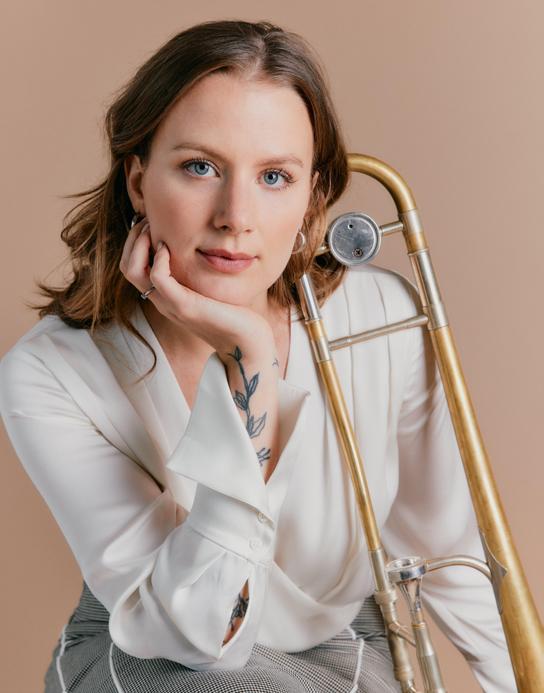
Bildsten’s most recent Outside in Music album, Steppin’ Out, was released in August 2023 and features Yamanaka on piano along with trumpeter Bruce Harris, alto saxophonist Sarah Hanahan, tenor saxophonist Ruben Fox, bassist Barry Stephenson, and drummer TJ Reddick. Among the selections are Duke Ellington’s “Downtown Uproar” and Jimmy Van Heusen’s “Polka Dots and Moonbeams.”
Lawrence Brown, who played in Ellington’s Orchestra for several years, is Bildsten’s trombone hero. “He is one of my favorites,” she told Jersey Jazz (January/February 2020) “because of the way he expressed his melodies. He would have you on the edge of your seat.” Bildsten’s 2020 Outside in Music album, Backbone, was called “a joy to encounter” by JazzTimes and “a straight up, swinging, purist mix of tunes from across the ages” by New York Music Daily. Yamanaka moved to New York
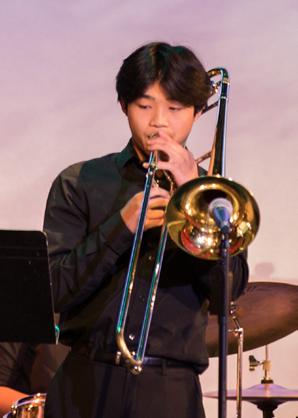
Ming-Lang Qin
City from Japan in 2012. Her latest Cellar Records album, Shades of a Rainbow, showcases her original compositions. Her piano playing, according to AllAboutJazz’s Jack Bowers, is “nimble and expressive.”
Originally from Conway, MA, Jaffe also moved to New York in 2012, to attend Columbia University and Juilliard, where he studied with bassists Ron Carter and Ray Drummond. He was named a 2012 Presidential Scholar in the Arts
and won the International Society of Bassists’ jazz competition in 2013.
In a review of Goold’s 2022 LaReserve album, Rhythm in Contrast, Giovanni Russonello of The New York Times praised the drummer for providing “a sincere update to the mid-century modern jazz sound.”
The Mariel Bildsten Quartet will be preceded by a Rising Stars quartet led by Pascack Valley High School trombonist Ming-Lang Qin. Other members of the band are: drummer Cole Rosenberg from Saddle River Day School and two student musicians from Ridgewood High School, bassist Anders Ryen and pianist William Solway. Qin was a member of the New Jersey AllState Ensemble that performed at last November’s TD James Moody Jazz Festival at the New Jersey Performing Arts Center. Rosenberg attended last summer’s Litchfield (CT) Jazz Camp, playing in a band led by saxophonist Steve Kortyka. Qin and Rosenberg are
both members of the Jazz House Kids Big Band, which tied for first place at the Charles Mingus Festival and High School Competition held in February at The New School in New York.
The Madison Community Arts Center is located at 10 Kings Road in Madison, NJ. The Jersey Jazz LIVE! concerts begin at 3 p.m. Admission will be $10 for NJJS members and $15 for non-members. Student admission is $5 with valid ID. There will be light refreshments for purchase.
To order tickets in advance, log onto madisonarts.ticketleap.com/ njjs-bildsten-05-05-24/.
: Funding for Jersey Jazz Live! has been made possible, in part, by funds from Morris Arts through the New Jersey State Council on the Arts/Department of State, a partner agency of The National Endowment for the Arts. This program is also proudly supported by a grant from The Summit Foundation.
“Austin’s
Arrangements Focus Deeply on the Appealing Flavor of Wonder’s Mainstay Hits”
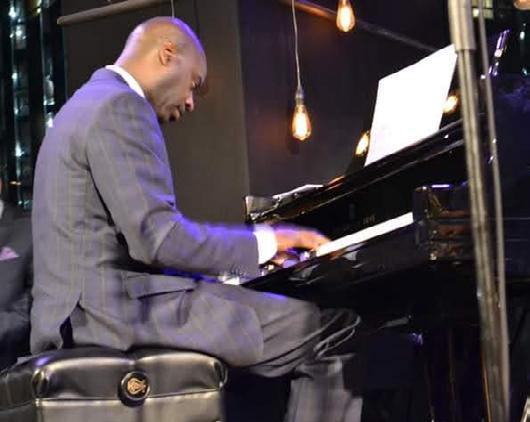
When pianist James Austin, Jr. released his 2018 album, Songs in the Key of Wonder, jazz interpretations of music by Stevie Wonder, AllAboutJazz’s Geannine Reid pointed out that, “Others have covered Wonder’s tunes on numerous occasions and for good reason, but Austin’s arrangements focus deeply on the colorizations and appealing flavor of Wonder’s mainstay hits.”
On Sunday, May 19, in Toms River, NJ, at the Jay and Linda Grunin Center for the Arts’ Jazz on a Sunday Afternoon series, Austin will bring a quartet that includes two of the musicians who were on that album with him—saxophonist Jarrard Harris and bassist Ben Rubens. They will be joined by drummer Kayvon Gordon for a concert that will combine several selections from Songs in the Key of Wonder with jazz classics and
standards from the Great American Songbook. Austin’s concerts at venues throughout the Tri-State area are known for their versatility, often featuring tunes such as Cole Porter’s “What Is This Thing Called Love?”, Dizzy Gillespie’s “Con Alma”, and Juan Tizol’s “Caravan”.
Originally from Chicago, Austin studied under legendary jazz pianist Barry Harris. He curates and leads the New Jersey Performing Arts Center Jazz Jam series and has served as the Musical Director for vocalist Alexis Morrast. Austin is a former semifinalist in the Thelonius Monk International Jazz Piano competition and served as pianist and arranger for two concerts at Carnegie Hall led by Ray Chew, Music Director of ABC’s Dancing With the Stars.
Jarrard Harris studied jazz at the University of Cincinnati Col-

lege Conservatory of Music and at DePaul University. He is currently on the jazz faculty of Northwestern University and serves as the Director of Jazz Studies with the Chicago Public Schools Advanced Arts Education Program. Harris was a founding Board member of the Jazz Education Network and is a current Board member of the Jazz Institute of Chicago. Rubens studied bass under Har-
vie S and the late Bob Cranshaw and often accompanies the legendary vocalist Sheila Jordan. He has performed at the Kennedy Center and at the Detroit, Nice, and Brussels jazz festivals. Gordon was a protege of trumpeter Marcus Belgrave and has performed with tenor saxophonist Joe Lovano, trumpeter Wynton Marsalis, and pianist/vocalist Johnny O’Neal, among others.
: The New Jersey Jazz Society is a proud supporter of the JOSA series, which is made possible, in part, through the support of the Wintrode Family Foundation. The Grunin Center is located on College Drive on the campus of Ocean County Community College. The concert begins at 3 p.m., and tickets can be ordered at the box office, by logging onto grunincenter.org, or by calling (732) 255-0500.


“When
Atalent like bassist, singer, and composer Esperanza Spalding emerges only several times throughout a lifetime. She is clearly one of the most celebrated and creative jazz musicians of the millennium.
The five-time Grammy Award winner grew up in Portland, OR. By age five, she was already playing the violin professionally with the Chamber Music Society of Oregon and remained with the group until she was 15. She also taught herself oboe, clarinet, and guitar; and later settled
on the bass. Gifted with an incredible inherent ability, Spalding credits her mother and the support of a strong community of musicians and teachers for her development and nurturing.
“I had an amazing mom. As I got older, I further realized what an anomaly she was. She was born in the ‘40s and was an incredibly intelligent person. Adults told her to hide her intellect to find a husband, but she challenged authority. She was not confrontational, aggressive, or offensive but would take a stance when
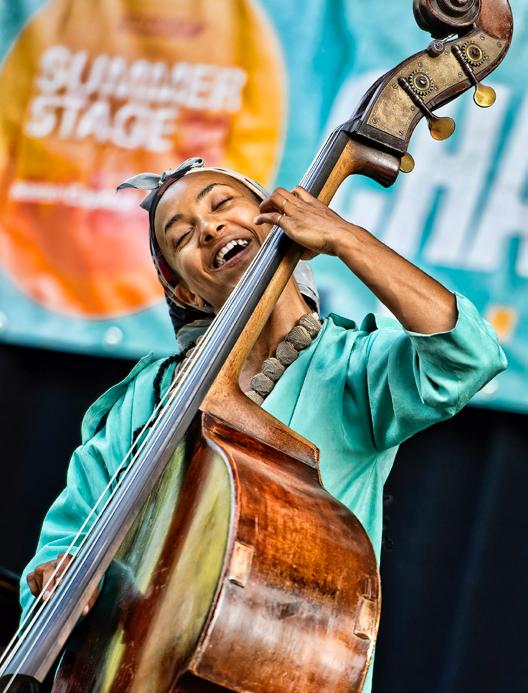

needed. She is incredibly loving and caring and committed to her values around honoring humans, life, nature, and relationships. Her model for living deeply influenced me to the point where I never felt pressure to do what people said. I was also surrounded by many grown musicians who took their precious time to run sophisticated music programs for
children. Their mentorship taught me that music and composition are valuable and precious. It taught me how music can create a community.”
The 39-year-old Spalding is excited about her upcoming tour, which will stop at Princeton’s McCarter Theater on June 2, as part of its Jazz in June series. What should audiences expect? “We will perform a combination of all
my work and new work. I have been co-directing a dance company and will share some of that project. For the last 12 years, I have done projects with big staging, but I wanted to offer a more stripped-down and intimate music exchange with these shows. I just want to offer my songs and my bass playing as the show’s essence. The group will consist of three musicians, including me, and two dancers. The performance concept is tracking through one’s day. It’s meant to display a world in which music fully integrates into everything we do daily. A musical experience of rising, being with loved ones, and returning to the dream realm. So, the music is meant to accompany each part of the day. That said, the songs themselves will be the main focus.”
While trained initially on in the classical traditions, Spalding’s early influences and musical tastes were varied. When asked about her influences, she mentioned various artists
and composers. “Some of my earliest influences were Rimsky-Korsakov, Beethoven, and Mendelssohn. I also liked Motown and Stax Records, DeeLight, and Tori Amos. Then I got into Ella Fitzgerald, Duke Ellington. Then I learned you could improvise on the violin, which was cool because I was getting a little tired of being a violinist. When I became interested in improvisation, I heard a Lionel Hampton record with bassist Slam Stewart. I also heard something from Sonny Stitt that I can’t remember, but I listened to it repeatedly; it destroyed me.”
By age 15, Spalding was already playing, singing, and writing music with a local indie rock group, Noise For Pretend. By 16, she had earned her GED and was offered a music scholarship to Portland State University, which she accepted, making her the youngest bassist in the program. She then received a full scholarship to Berklee College of Music in Bos-
ton, where she came to the attention of Pat Metheny and Gary Burton, and they encouraged her to continue her musical pursuits. Following graduation, she was hired to teach at Berklee, making the 20-year-old one of the youngest professors ever on the faculty of the esteemed institution.
In 2006, the bassist/singer released Junjo on the Ayva Musicia label, the first of her many impressive albums. In 2008, she released her second record, Esperanza (Concord Music Group), showcasing her love and incorporation of various genres
by blending jazz, Brazilian music, folk, pop, and hip-hop elements. In 2009, Spalding performed for the first time at the White House, where she came to the attention of the Obamas, who became strong supporters of her music.
“I was first invited to the White House by Stevie Wonder,” she recalled. “He was being honored, so he invited all the musicians who had a connection to him. I think he had a radio program for a time, and he heard one of my recordings. He liked the song, and he invited me to participate. That’s how I ended up there.
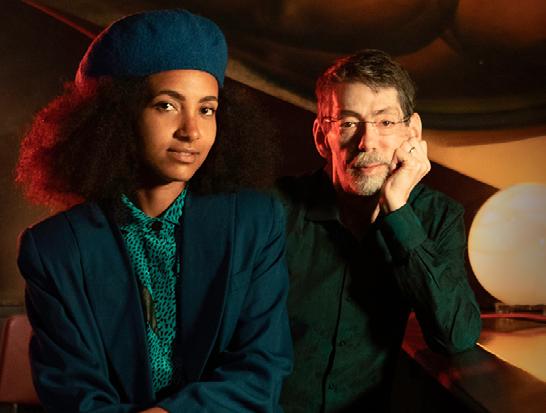
Spalding with Fred Hersch
“
I performed for the Obamas at the events and then some other events they hosted (including the 2009 Nobel Peace Prize ceremonies in Oslo).”
In 2010, Spalding released the widely celebrated Concord album, Chamber Music Society, and in 2011, she was awarded Best New Artist at the 53rd Grammy Awards. Others nominated in the category included Justin Bieber, Drake, Florence and the Machine, and Mumford & Sons,
all bands and musicians in more popular categories than jazz For many, including Spalding, the nomination and the win were an unlikely surprise.
“It was a special feeling,” she said, “to know that your peers took the time to fill in a bubble next to my name to express their appreciation for your music and belief in you. It is beautiful that people took the time to advocate for musicians. I didn’t follow the Grammys up till that nomination.
However, I thought it was bizarre that I would be nominated for the Best New Artist category because we associate that category with more popular music. I had no expectation of winning. The entire experience was hilarious. I looked at it as a party for my friends.
“Having been nominated for the category,” she continued, “I received a lot of free tickets, so I brought along my family and friends. We looked at it as a free way to get to the Grammys so we could have fun. Prince had an afterparty, and I knew him at that point. It was all part of the fun. Then I won and was like, ‘What the hell, this makes no sense.’ It was funny but very cool how the thing that I was already doing musically got a big push, and it opened up a lot of doors and resources for me to continue to do these projects that I love with the people I love. It created opportunities. It gave me more name recognition.”
The Grammy win certainly

Receiving her Grammy
brought her to greater national attention, which led to further industry interest. “When you become a person who is perceived to have commercial viability,” she reflected, “there is all kinds of pressure to do stupid shit. That’s part of the dance, but I am fortunate in that I am who I am, and I was raised in a certain way that I wasn’t susceptible to any kind
of industry pressure. However, I reflect on some things I have done and think, ‘Why the hell did I do that?’
It was because I was taking advice from people I believed knew more about the music industry than I did.”
Spalding followed Chamber Music Society with a string of albums, all creative and varied in genre and instrumentation. Her fourth release, Radio Music Society (2012: Heads Up), featured a blend of soul, gospel rhythm & blues and jazz, had crossover appeal and peaked at Number 10 on the Billboard 200 Charts and Number 1 on the jazz charts,and earned Spalding two more Grammy Awards. She followed with Emily’s D+Evolution (2016: Concord Music Group), which further explored funk, R&B, and pop elements and again earned her the top spot on the jazz charts.
Her last solo effort, Songwrights Apothecary Lab (2021: Concord Jazz), came from a profoundly spiritual
place. The album was intended to bring together the healing practice of musical therapy, neuroscience, and Sufism ( a mystic body of religious practice found within Islam) in a blend of music from African-American music and South Indian music. In addition to her solo releases, Spalding has collaborated frequently with other mainstream jazz artists such as the late saxophonist Wayne Shorter and the pianist, Fred Hersch. Live at the Detroit Jazz Festival (Candid: 2022) was recorded at the Carhartt Amphitheater Stage during the 2017 Detroit Jazz Festival. It was one of Shorter’s final performances before his death in March 2023 and was a tribute to the late pianist/composer Geri Allen. Joining Shorter and Spalding on the album were drummer Terri Lyne Carrington and pianist Leo Genovese. It was nominated for Best Jazz Instrumental Album, and Shorter and Genovese won Grammys for Best
Improvised Jazz Solo on the track, “Endangered Species”, written by Shorter, Spalding, and Joseph Vitarelli.
In 2021, Spalding and Shorter co-wrote an opera, Iphigenia, which premiered in November 2012 at Boston’s Cutler Majestic Theater and then was performed at the Kennedy Center a month later.
Spalding’s collaboration with Hersch was Alive at the Village Vanguard (Palmetto Records: 2023). It contained two compositions by Hersch, plus a mix of Songbook standards and jazz classics such as the Gershwins’ “But Not For Me”, Jule Styne and Sammy Cahn’s “Some Other Time”, and Charlie Parker’s “Little Suede Shoes”. Hersch and Spalding celebrated the album’s release with a concert at the New Jersey Performing Arts Center on January 29, 2023.
Reviewing the album for AllMusic, Matt Collar wrote: “Alive at the Village Vanguard captures pianist
Fred Hersch and vocalist Esperanza
Spalding in an intimate yet inventively expressive duo performance. On first glance, the combination of Hersch (a veteran performer known for his lyrical standards work) and Spalding (a virtuoso bassist and singer known for her highly conceptual, genre-bending albums) may seem like an odd pairing. Yet there’s an unconventional, somewhat maverick, streak running through both artists, one that balances a core respect for the jazz tradition with a desire to draw inspiration from other mediums like art, poetry, and literature.”

: The Esperanza Spalding concert at the McCarter Theater will begin at 7 p.m. on Sunday, June 2. The two other concerts in the Jazz in June series are: trumpeter Chris Botti, 8 p.m., Saturday, June 1, and saxophonist Lakecia Benjamin at 7:30 p.m. on Wednesday, June 5. For tickets and information, log onto mccarter.org or call (609) 258-2787. For the complete performance schedule, visit grunincenter.org.
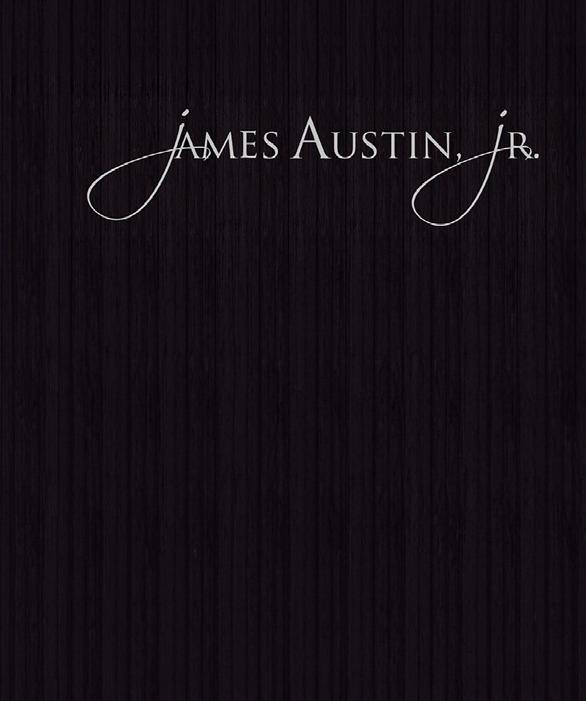
Sunday, May 19 • 3:00pm



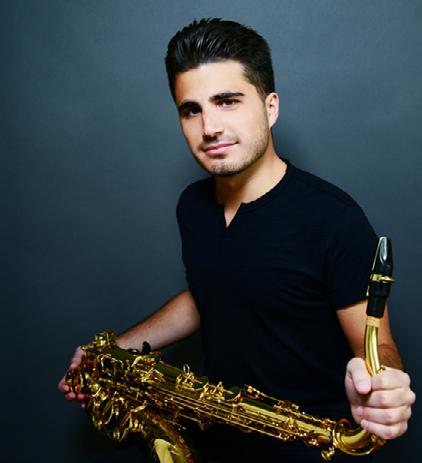
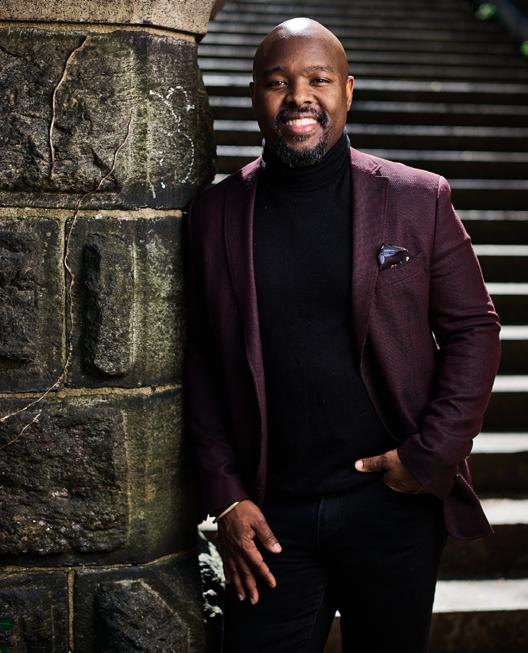
‘I’m
a Model’
“If You Want to Grow, You’ve Got to be Mentored and Have an Uncanny Ability to Play”
BY SANFORD JOSEPHSON
Drummer Ulysses Owens, Jr.’s Cellar Music album, A New Beat, featuring his Generation Y of up-and-coming young jazz artists, spent eight weeks at Number 1 on the JazzWeek charts.
That success with emerging artists has prompted some to describe Owens as a modern-day Art Blakey, the legendary drummer who nurtured so many young talents. Owens’ response: “Not to diminish my hard work, but I would not have become what I am today if not for those who helped me. I’m just repeating a model.”
Growing up in Jacksonville, FL,
Owens was supported by a lot of local musicians “who sort of reared me and helped me get to New York.” Once he got to New York after being accepted to Juilliard, his two key mentors were the late pianist Mulgrew Miller and multi-reedist Victor Goines. “To be completely honest,” Owens said, “I did not even know who Mulgrew was. Of course, he was a great player, but he came over to the drums and took my hand and said, ‘You got to play this way.’ First of all, nobody had ever given me that much attention. Secondly, he wasn’t a drummer. He became my mentor, and, later on, I understood
that he had played with Art Blakey and Tony Williams. And, he used to tell me all those stories about Blakey.”
His other mentor, Goines, was the first Artistic Director at Juilliard Jazz.
“I always say I thought he hated my guts, but, actually, because he was so hard on me, he made me a great musician. So, that I’m being compared to Art Blakey—I think it’s incredible because it’s the true tradition of the music. If you want to grow, you’ve got to be mentored and have an uncanny ability to play.” (Owens will be performing with Goines’ quartet May 17-19 at New York’s Dizzy’s Club).
Owens is currently Small Ensemble Director at Juilliard Jazz, and one example of those he has mentored is alto saxophonist Sarah Hanahan, who can be heard on A New Beat and was a Jersey Jazz Rising Star in September/October 2020. “When I first met her,” Owens recalled, “she was fresh
off the train from Connecticut (She had graduated from the Hartt School of Music Jackie McLean Institute at the University of Hartford and came to New York to get her master’s degree in Jazz Studies at Juilliard).
I was with the Mingus Band, and I said, ‘I’ll hire you and put you front and center.’ She not only played beautifully; she was a star.” With young musicians, he said, “first and foremost, there has to be a talent. And there has to be a teachable spirit. I met Sarah during the Covid year. That was fall of 2020. We started virtually and then Juilliard had us come back in January 2021. I made the students write an essay of ‘What are you against? What bothers you?’ Sarah wrote about misogyny, the disrespect she had experienced as a woman in jazz. She was so passionate. That’s when I decided to hire her. What was in that anger was a lot of beauty.”

Generation Y, from left, Luther Allison, Erena Terakubo, Ryoma Takenaga, Benny Benack III, and Ulysses Owens, Jr.
In her audition for the Hartt School, Hanahan played “I Hear a Rhapsody”, which was recorded by alto saxophonist Jackie McLean on his 1960 Prestige album, Makin’ The Changes. She told me that McLean was her biggest influence, and Owens pointed out that, “There’s a direct connection between Sarah and Jackie McLean, by design. Jackie McLean created a whole community and fostered
the music in the way he embraced it, but to create a pathway. And, Sarah’s a part of that crew.” McLean, who also had a knack for spotting young talent, appeared on six Art Blakey albums recorded in the 1950s. He passed away in 2006 at the age of 74.
Like the young musicians who played with Blakey, Hanahan has now moved on from Generation Y. “Sarah’s actually no longer in the band
“There’s a direct connection between Sarah (Hanahan) and Jackie McLean, by design.”
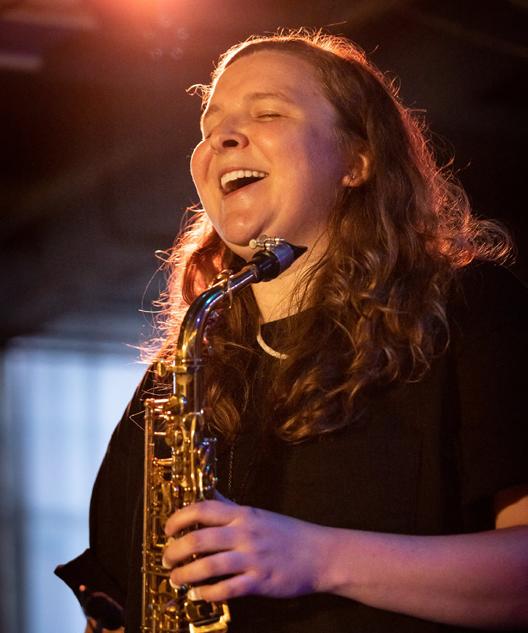
because I said, ‘Go do your own thing. I’m excited to hear her new record coming out from Blue Engine and what she’s going to be doing with (drummer) Joe Farnsworth, taking her to the next dimension.” Hanahan will preview her new Blue Engine album, Among Giants, on June 6 at Dizzy’s Club. Her quartet will include pianist Marc Cary, bassist Nat Reeves, and drummer Jeff ‘Tain’ Watts. Reeves is another of her mentors. He was a Hartt faculty member, and she told me, “He used to pull me up on stage even when I wasn’t ready. I’m so grateful to him for that.” Hanahan has appeared recently with Farnsworth’s quartet at Greenwich Village’s Smalls and Chris’ Jazz Cafe in Philadelphia.
Owens took a quartet to Tokyo in March with two young musicians who were on A New Beat—trumpeter Anthony Hervey and pianist Tyler Bullock—and two new mem-
bers of Generation Y—saxophonist Langston Hughes II and bassist Thomas Milovac. In June, Owens is doing a Canadian tour, with trumpeter and A New Beat band member, Benny Benack III, replacing Hervey on trumpet. Hervey and Bullock have been featured as Jersey Jazz Rising Stars (April 2022 and February 2024, respectively). Owens produced Hervey’s debut album, Words From My Horn (Outside in Music: 2023), and Hervey’s composition, “Better Days”, is repeated on A New Beat. Bullock, currently one of Owens’ Juilliard students, is also the pianist with the Roy Hargrove Big Band.
Hughes, who Owens said is “burning up the scene,” is currently pursuing a master’s degree at Juilliard, has also toured with Wynton Marsalis and The Jazz at Lincoln Center Orchestra, and has performed with such artists as vocalist Jazzmeia Horn and pianist
Orrin Evans. Milovac is described by Owens as “my quiet storm. He lives in Orlando so nobody knows about him. This cat’s got some McBride, some Ray Brown, some Scott LaFaro.”
Generation Y was started in 2019. “We did one gig at the Jazz Standard and Covid happened.” By the time he could get back on the road and build a new band, some of the key members, such as alto saxophonist Alexa Tarantino and pianist Luther Allison, had moved on. A New Beat is a combination of young talents. “I told Corey Weeds (saxophonist and owner of Cellar Mu-
sic), “We’re gonna play everybody on the record.” In addition to Hanahan, Hervey, Bullock, and Benack, A New Beat includes performances by Allison, alto saxophonist Erena Terakubo, bassists Philip Norris and Ryoma Takenaga, and vocalist Milton Suggs.
Takenaga, from New Providence, NJ, is studying jazz at New York University and has been featured twice in Jersey Jazz. In May/June 2020, he was profiled in a Rising Stars article about three students who received multiple awards at the Charles Mingus Festival. and High School Competition held

every February at The New School in New York City. In May 2021, he was part of a feature about the three New Jersey high school students who were accepted into that year’s Carnegie Hall NYO Jazz Orchestra. Owens first encountered Take-
“
”
naga at an NYU workshop. “He’s an incredible musician. I took him to Europe with me. Right after that tour, (trumpeter) Christian Scott picked him up. Now, he’s everywhere.” Terakubo was the cover story in the October 2023 issue of Jersey Jazz in connection with her appearance at the South Jersey Jazz Society’s Jazz@ ThePoint Festival in Somers Point. In 2022, she was invited by Music Director John Beasley to perform at International Jazz Day, and on May 14 she will be appearing in San Diego at two concerts called “John Beasley and the Next Generation”, curated by alto saxophonist Charles McPherson for the La Jolla Music Society. Her mentor, alto saxophonist Vincent Herring, calls her “the world’s best female alto saxophonist.” Terakubo met Owens at the Tokyo Jazz Festival. “She was there playing with the great (trumpeter) Teramasu Hino,” he recalled. “She

kinda stuck in my mind. She’s great.” Reviews of A New Beat have been very enthusiastic. Jersey Jazz’s Joe Lang wrote that, “The young players flawlessly execute the demanding charts conceived by Owens. The excitement generated by these players illustrates that the future of jazz is in good hands.” According to AllAboutJazz’s Glenn Astarita, “The band supremely carries the torch of Art Blakey’s Jazz Messengers manifesto, serving as a dynamic incu-
bator for emerging jazz talent amid hard-swinging choruses and dynamic bop interplay.” AllMusic’s Matt Collar praised Owens “whose dynamic, intensely swinging style propels the group forward throughout the album,” adding that, “players like trumpeter Benny Benack III and saxophonist Sarah Hanahan are on the cusp of great things and just coming into their own as players. Particularly thrilling is their improvisational sparring on (Jackie McLean’s) ‘Bird Lives’.” He also singled out Hervey’s “warm-bodied solo” on Roy Hargrove’s “Soulful”.
Owens acknowledged that, “I do have an ability to spot talent,” and his overall goal is that, “If a person goes on the road with me and gets that experience, they could emerge to something greater. That’s my hope with Generation Y. For every person you see in the lineup, I’ve got two or three others waiting to go on the road.”


SUNDAY, JUNE 9
DOORS OPEN 2:30 PM
AFRO PERUVIAN JAZZ
$ 10 MEMBERS | $ 15 NON-MEMBERS
$ 5 STUDENTS (WITH VALID I.D.)
“We Picked One of Ellington’s Most Difficult Pieces.”
At the 1956 Newport Jazz Festival, the final set was performed by the Duke Ellington Orchestra. In his autobiography, NJF Founder George Wein described what happened at that concert, when the band played a combination of “Diminuendo in Blue” and “Crescendo in Blue”.
Saxophonist Paul Gonsalves, he wrote, “dug in with his tenor and started blowing. Somewhere around the seventh chorus, it happened. A young blonde woman in a stylish black dress sprung up out of her box seat and began to dance. She had caught the spirit, and everyone took
notice—Duke included ... The tune ended, and the applause and cheering was immense—stronger, louder, and more massive than anything ever heard at a jazz concert before.”
When Newark Academy’s Chameleon Jazz Band takes the stage later this month at Jazz at Lincoln Center’s Essentially Ellington High School Jazz Band Competition & Festival, one of the three pieces it will play will be “Diminuendo and Crescendo in Blue”. This will be Newark Academy’s seventh time as an EE finalist (finishing second in 2018), but in 2023, said Julius Tolen-
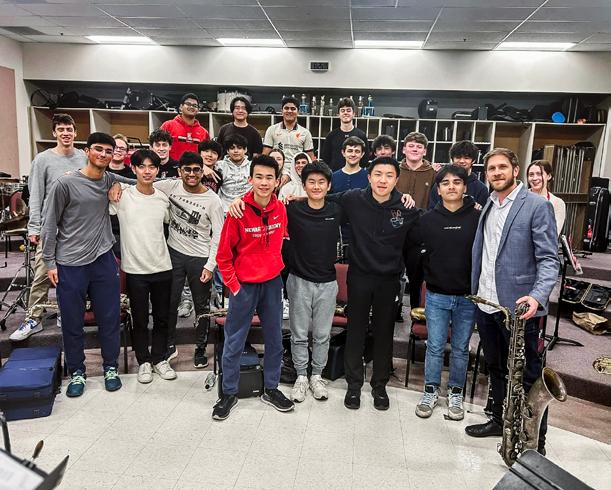
tino, the Director, “We didn’t make it, and the kids were devastated. From that point on, they were so focused on getting better together and really pushing themselves to the next level.
“This is one of the strongest bands I’ve ever had at Newark Academy,” he continued, “and they wanted to play some harder music. So, that’s what we did. We picked one of Ellington’s most difficult pieces. ‘Diminuendo and Crescendo in Blue’ kind of brought back the Ellington band’s career in a way at Newport, with Paul Gonsalves’ 11-minute chorus. So, we want to bring that kind of energy to it.” The tenor saxophone solo will be played by NA student Anin Chakravarthy, a previous Outstanding Soloist Award winner at the Charles Mingus High School Competition and Festival held every year at The New School of Jazz in New York City.
Fifteen high school bands from across the country are chosen each

year as Essentially Ellington finalists, and each band that enters the competition is required to submit three recorded tunes from the Essentially Ellington Library.
Last summer, members of the NA band started preparing for this year’s Essentially Ellington competition.
“We hadn’t had that before, where we got together before the school year started to work on some music,” Tolentino said. The other two Ellington
pieces selected by the Newark Academy band are “Golden Cress” and “Boy Meets Horn”. “Golden Cress”, said Tolentino, “was originally a feature for Lawrence Brown on trombone, and it’s going to be played by Vanessa Fang, an outstanding trombonist.” The third piece, “Boy Meets Horn”, featured Ellington trumpeter Rex Stewart. The soloist on that performance will be Tolentino’s son, trumpeter Jacob Tolentino. Fang and Tolentino
were members of last year’s New Jersey High School All-State Jazz Ensemble that played at the TD James Moody Jazz Festival in November.
Each finalist is visited by a member of the JALC Orchestra, who acts as a clinician helping them prepare for the competition. Newark Academy’s clinician this year is baritone saxophonist Paul Nedzella. Tolentino and Nedzella used to play together in the George Gee Swing Orchestra. “My students are so excited to work with him,” Tolentino said. “Paul took over (the late) Joe Temperley’s chair in the Jazz at Lincoln Center Orchestra. He’s somebody who embodies Joe’s whole concept in sound.”
When Nedzella released his first album as a leader in 2020, Introducing Paul Nedzella (Outside in Music), London Jazz News’ Frank Griffith wrote that his, “full, broad, yet razor-sharp, sound combines the warmth of Gerry Mulligan with
the fiery intensity of Pepper Adams and Ronnie Cuber. A wonderful fusion of qualities recognizing such a wide range of the legacy of the horn.”
The 29th annual Essentially Ellington event will be held from May 9-11. The students will spend three days immersed in workshops, jam sessions, rehearsals, and performances at Frederick P. Rose Hall. “The first day of the festival,” Tolentino said, “never gets old. All the bands are on the top floor at Jazz at Lincoln Center. And, it’s Wynton Marsalis’ big band playing as we walk in. It’s surreal.”
On April 13, in celebration of Newark Academy’s 250th anniversary, Tolentino brought back some of the school’s jazz alumni to play with student jazz groups during NA’s annual Evening of Jazz concert, a fundraiser for the Ana Grace Project, founded by saxophonist Jimmy Greene and his wife Nelba, whose daughter, Ana Grace, was killed in the Sandy Hook
Elementary School shooting tragedy in 2012. Tolentino and Greene were roommates at The University of Hartford’s Hartt School of Music.
Earlier that day, Newark Academy held its seventh annual regional Essentially Ellington Festival in partnership with JALC. (In addition to the Competition & Festival in New York City each May, Essentially Ellington co-produces non-competitive, education-focused festivals at various locations across the country, designed to offer high school jazz bands of all levels the opportunity to perform the music of Duke Ellington and other seminal big band composers and arrangers). At Newark Academy, 15 high school bands from New Jersey, New York, and Pennsylvania—plus a band from Australia—participated. Alto saxophonist Vincent Herring was a guest clinician and performed with NA’s big band—SJ

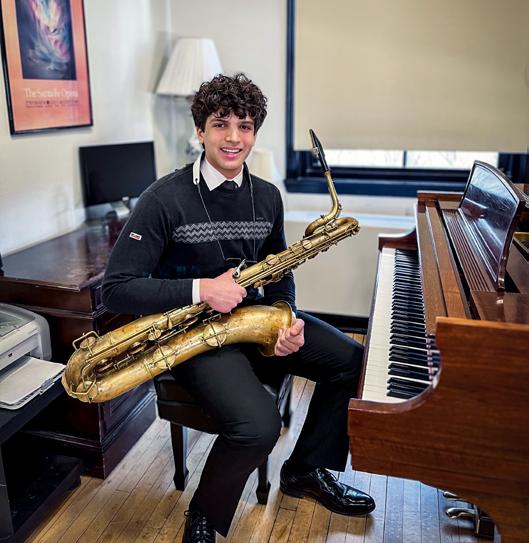
Baritone Saxophonist Evan Gongora: Inspired by the ‘Virtuosity’ of Pepper Adams
“Evan
Has a Special Gift that will Take Him as Far as He Wants to Go in the Music Business”
BY SANFORD JOSEPHSONEvan Gongora’s father, Oscar, is a classical saxophonist and Founder and Director of The Vitral Saxophone Quartet. “So,” recalled the 18-year-old Evan, “he put a saxophone in my mouth at a very early age.” Evan “fell in love with the baritone saxophone. I loved the sound. I always listened for all the low sounds, songs built on the low notes of the chords. It really blends everything together.”
Growing up in East Hanover, NJ, Gongora became serious about jazz at age 14, performing as a member of
the Hanover Park High School jazz band and taking private lessons from saxophonists Chris Bittner and Andrew Gould and baritone saxophonist Gary Smulyan. By this time, he had become aware of the “virtuosity” of the celebrated bari player Pepper Adams. “He played bari sax like it’s an alto,” Gongora said. “He could just fly and play at whatever tempo with such accuracy and such clear articulation. Transcribing him is one of the easiest things to do because you can hear every single note. I just love the way he played. It’s really pow-
erful. He has a lot of joy through his playing, and you can really feel that.”
Gould was impressed with Gongora’s “dedication. I had an awesome time working with him in our lessons together! We got into all sorts of fun musical topics, and he really scooped up every idea we spoke about. Most of all, he had a great attitude and driven work ethic. The sky is the limit!”
Joseph Spina, Coordinator of Music/Director of Bands at Hanover Park High School, described Gongora as “an incredibly talented and hardworking musician. For many years,
“
since he was in middle school, I’ve known Evan to be very driven and focused on his musical and academic growth. I’ve very excited to see where his performance endeavors take him in the near and distant future.”
During his junior year of high school, Gongora auditioned for the New Jersey Youth Symphony Jazz Orchestra, one of the programs of Berkeley Heights, NJ-based Wharton Arts. There, he studied with trombonist Dion Tucker, the NJYSJO Director, as well as tenor saxophonist Lance Bryant, and baritone saxophonist Dave
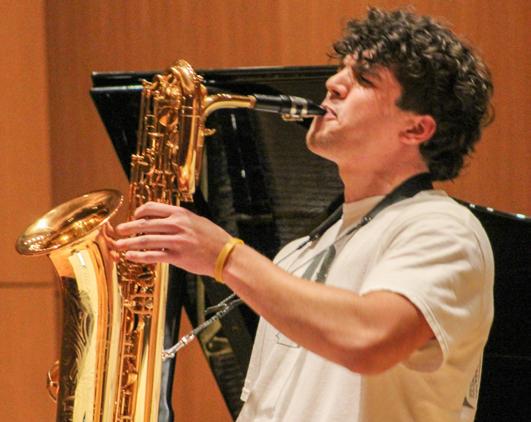
Schumacher. “Dion Tucker has been great in getting me to play more melodic,” he said. “Lance Bryant invited me to rehearse with his big band, and Dave Schumacher helped me figure out a good mouthpiece. Because I play on a vintage horn, making sure that I have a compatible mouthpiece is important, and he actually is letting me borrow one, which is amazing. They’re all super helpful, and they’re really a
big influence on my future career.”
Tucker described Gongora as “a natural leader in all of his ensembles. He leads by example, which, in my opinion, is the only way to lead. I love Evan’s attention to the details in the music. He’s constantly looking for subtle nuances that make the music and his playing special. It’s obvious to me that Evan has a special gift that will take him as far as he
wants to go in the music business.”
Recalling the rehearsal Gongora did with his big band, Bryant said, “From hearing him playing with the NJYS band, I could tell how serious he was and how much time he spends learning the music on his own. When a young musician plays in a musical
language and feel that is consistent with the jazz tradition, you know he has put in the time and work at home. An experienced musician can hear it right away. These are things that can’t be acquired in a classroom.”
In the fall, Gongora will be attending William Paterson Univer-
sity as a Jazz Performance major.
“Dr. Demsey (WPU Coordinator of Jazz Studies, David Demsey) was so welcoming to me,” he said, “and I have a chance to study with saxophonists such as Dayna Stephens, Rich Perry, and Vincent Herring.”
Said Demsey: “When our faculty

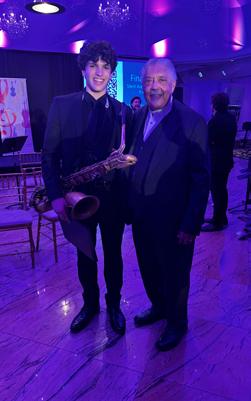
first heard Evan, we knew that he had something very special and has limitless potential for his future. As I have gotten to know him, I am increasingly impressed by his knowledge for someone so young and for his already deep commitment to the music and to his instrument. We are all very excited to have him as part of our William Paterson community starting next fall!”
Gongora is grateful to all of his teachers “Without them, I wouldn’t be where I am. Chris Bittner was the first to tell me to transcribe. He taught me the blues and helped me with the basics, using all of my skills and all 12 keys. Andrew Gould helped a lot with my tone development. With Gary Smulyan, we do a lot of experimenting. A lot of times, he asks me what I want to know. He gives me a lot of harmony, diminished patterns. He’s taught me a lot about that. He encourages me to listen to transcriptions and to learn tunes.”
‘An
Youngest of the Heath Brothers Started Out as the Drummer on John Coltrane’s First Recording
Drummer Albert “Tootie” Heath made his first recording on John Coltrane’s debut as a leader, the 1962 Impulse! album, Coltrane. After learning of Heath’s death on April 3, 2024 in Santa Fe, NM, at the age of 88, pianist Benny Green recalled, on Facebook, that he had once asked Heath about that recording. “I asked whether he’d felt at all nervous during this recording session ... Tootie simply responded: ‘No, I was hired to play, and I knew I had a job to do.’”
That humble response notwith-
standing, Heath was often a comedic raconteur. Last fall, when he appeared as a guest with pianist Emmet Cohen’s trio in Santa Fe, he introduced Blue Mitchell’s “Fungi Mama” by saying, “This song is not a calypso. Because I’m 88, it’ll be a collapse-o.”
In a Facebook post, Cohen described him, as “one of the most beautiful human beings the world has ever known. He brightened our lives, and I’m so grateful for the time spent together, the laughs, and the endless wisdom.”
The younger brother of bassist Per-

cy Heath and tenor saxophonist Jimmy Heath, Albert Heath was born on May 31, 1935, in Philadelphia. His nickname was given to him by his grandfather, after the ice cream flavor, tutti-frutti.
Following his inaugural recording with Coltrane, Heath played with flugelhornist Art Farmer and tenor saxophonists Dexter Gordon and Sonny Rollins, among others. In 1974, he released an album on the Muse Records label called Kwanza (The First), which featured his brothers along with trombonist Curtis Fuller, pianist Kenny Barron, and guitarist Ted Dunbar. Two years later, the Heath Brothers began regularly performing and recording together.
Reviewing their 1997 Concord album, As We Were Saying, Robert Spencer of AllAboutJazz wrote, “Next time the kids come by with their Counting Crows and Smashing Pumpkins discs, show them what real music sounds like.” In the late ‘90s, Heath
sometimes played with the Modern Jazz Quartet, which included his brother, Percy, on bass; John Lewis on piano; and Milt Jackson on vibraphone.
WRTI-FM’s Nate Chinen, writing on the day of Heath’s death, described him as “Never the flashiest or most ferocious of drummers,” but one with “an unwavering sense of time and a fluid, precise technique. He was prized in any rhythm section for those attributes but also because of his attunement to sonic clarity, which shines clearly on live recordings like the 1961 album, In Person (Live at the Village Vanguard) featuring his childhood
friend, Bobby Timmons, on piano and an impeccable Ron Carter on bass.”
Chinen interviewed Carter in 2020 for the liner notes to guitarist Greg Skaff’s SMK Jazz album, Polaris, which featured Carter and Heath in a trio setting. Heath, said Carter, “understood the range of the instrument he was playing with and the range of the bass player, at least as far as I was concerned.” Carter knew that “whatever I played, somebody would hear it because the drums were not too loud and were tuned in the right pitch to let the bass have a say-so in the rhythm and the sound
and the harmony.” When Joe Lang reviewed Polaris for Jersey Jazz, he wrote: “The chemistry was immediate and the results sound like a working band. Nice music, nicely played!”
In 2018, Heath received a Lifetime Achievement Award from the Jazz Foundation of America, and, in 2021, was named a National Endowment for the Arts Jazz Master, an honor earlier given to his brothers.
In a Facebook tribute to Heath, bassist Peter Washington pointed out that “he had unique qualities as a drummer, one of which was that generous ride cymbal beat and the way he had of sometimes mixing a straight eights feel into it. It was slick and slyly humorous, and it got down ... One of the greats.”
Survivors include his wife, Beverly.; two children; four stepchildren; nine grandchildren; and two great-grandchildren.
Continued on page 44

Dan Barrett sent me a clip of an interview with Jon-Erik Kellso that was broadcast on NPR. Jon was talking about his experiences in the recording studios. He said that he would often be required to play what the producers wanted to hear, rather than playing his own style of jazz. On one date, the producers were trying for something similar to the sound on Miles Davis’ Kind of Blue album and asked Jon to try to sound like Miles. It so happened that Jon had spent quite a lot of time studying Miles’ style, and on the first take, he imitated Miles very accurately. Jon said that, after the playback, he saw the producers huddling in the control room, looking concerned. Then, one of them said, “Jon, could you play that a little
Bill Crow is a freelance musician and writer. His books include Jazz Anecdotes, Jazz Anecdotes: Second Time Around, and From Birdland to Broadway. This column is reprinted with permission from Allegro , the monthly magazine of AFM Local 802.
LESS like Miles?” Evidently, they were afraid Miles might object.
Steven Cerra sent me a copy of his new book, Gerry Mulligan, Writings on a Jazz Original, a fine collection of writings about Gerry, including some of mine, plus some interviews. Steven writes: “The purpose of this book is to provide the reader with a sequential and thematic account of the life and music of Gerry Mulligan (April 5, 1927-January 20,1996). I’ve been enjoying reading it. Steven Included an anecdote from one of my books:
“… Gerry continued to work with his quartet: Brookmeyer, Mel Lewis, and me. We appeared on Mike Wallace’s television show during the time that Wallace was in the process of building a reputation as an investigative reporter. Wallace’s TV interviews were popular partly because of his prosecutorial style.
“At the rehearsal, Wallace was courteous and low-key. He asked questions that had been prepared by his staff, and Gerry answered frankly about his career, his experiences with drugs and the law, and other aspects of his life. On the air, Wallace’s tone became more contentious, and, instead of asking the questions he had asked at rehearsal, he said accusingly, “I understand you were involved with drugs, and did some time because of it!”
This left Gerry with little more to say than “yes.” Though Wallace was using the information Gerry had given him at the rehearsal, he gave his audience the impression that he was confronting Gerry with the results of his own private investigations.
Gerry managed to field Wallace’s questions with his usual aplomb, but he found himself at a loss when Wallace asked him, “I notice there are no Black musicians in your group. Is this accidental, or by design?”
Actually, it was the first time in years that, by happenstance, there were no Black musicians in Gerry’s quartet, but any short answer to that question would have sounded lame. As Gerry considered how best to respond, Bob Brookmeyer glared at Wallace, jerked a thumb at Mel Lewis, and said frostily, “We’ve got a Jewish drummer. Will that help?” Wallace dropped the subject.
Iplayed a lot of jobs with Marty Napoleon, all of them fun. He always played with enthusiasm and a big smile, but evidently that wasn’t always appreciated. He told me that,
when he joined Louis Armstrong’s All Stars, he saw that everyone was hamming it up, so he showed a lot of teeth while vigorously playing his first solo. When the tune was over, Louis came over to the piano to get a fresh handkerchief from the pile he kept there for mopping his brow. He bent over and whispered to Marty, “Uh, say, Pops, I do all the eye-rollin’ on this band!”
While I was playing some traditional jazz at Condon’s one night, Ed Polcer, the leader, held up three fingers to indicate the key of the next tune. Fingers pointed upward indicated sharps, and pointed
down indicated flats, but Ed’s fingers were pointing straight at me. “Is that sharps, or flats?” I asked. Ed laughed. “On this band, are you kidding?”
When I was playing recently at Smalls with Ryo Sasa ki’s quartet, Ryo announced Steve Little’s drum feature num ber by saying that Steve had played with many different bands, includ ing Duke Ellington and the band on Sesame Street. Steve suggested that we should play “C is for Cookie.”

At Newport, Lester Young was smoking a joint backstage. George Wein passed by and noticed what was going on. Smoking weed was still illegal in those days.
“Prez,” Wein cried, “What are you doing?” Prez replied, “Where are we?” Wein, nonplussed, said, “We’re at the Newport Jazz Festival!” Prez nodded and said, “Then, let us be festive.”

for more Sandy info
Rhythm Man by Stephanie Stein Crease
OXFORD UNIVERSITY PRESS, NEW YORK, 360 PAGES, 2023
Becoming Ella Fitzgerald by Judith Tick
W.W. NORTON & COMPANY, NEW YORK, 592 PAGES, 2024
BY JOE LANG
Chick Webb and Ella Fitzgerald are forever linked in jazz history. Webb led one of the hardest swinging bands of the Big Band Era and Fitzgerald started her rise to fame as a vocalist on Webb’s band. It is natural that Rhythm Man: Chick Webb and the Beat That Changed America by Stephanie Stein Crease and Becoming Ella Fitzgerald: The Jazz Singer
Who Transformed American Song by Judith Tick cover some overlapping territory in these two well-written and researched biographies. Webb was born in Baltimore in 1905 in humble circumstances complicated by the chronic spinal tuberculosis that affected him at three or four years of age. This disease impacts the growth in children, and Webb only

reached a height of “four feet with a deformed spine and a hump in his back, and he could barely walk until he had surgery a few years later.”
Despite his handicap, he was a hustler as a child, selling newspapers and doing other tasks to earn some money. He became fascinated with drums and, by the age of 11, had saved enough money to acquire a used drum
set that set the course of his life.
Having become sufficiently adept at playing the drums, he soon performed in local bands, grabbing gigs where he could. At age 20, he moved permanently to New York City, the most active center of jazz activity, scraping by playing at jam sessions, rent parties, and as a sideman.
At the urging of Duke Ellington, Webb formed his first band around 1926. It took awhile for him to become established as a leader, but by the early 1930s, he had the house band at the Savoy Ballroom.
Crease details the development of Webb’s band with emphasis on the leader’s distinct drumming talents. He was considered among the most exceptional of drummers for his intensity and creativity. The superior players who were on the band during its existence are an impressive list: trumpeter Taft Jordan,
alto saxophonist Hilton Jefferson, saxophonist Edgar Sampson (composer of “Stompin’ at the Savoy”) , saxophonist Louis Jordan, and bassist Beverly Peer, among others.
Of course, the biggest star to emerge from Webb’s band was Ella Fitzgerald. Fitzgerald was born in Newport News, VA, in 1917 but moved with her mother to Yonkers, NY, in the early ‘20s. After her mother died of injuries suffered in a car accident when she was 15, she was left in the care of her stepfather and then her aunt. Her behavior in school became problematical, and she ended up in reform school, eventually landing on the streets of Harlem where she earned what she could to survive until she had an opportunity to enter the amateur contest at the Apollo Theater. Initially intending to dance, she was intimidated by the preceding dance, so she sang

the only songs that she knew, “Judy” and “The Object of My Affection.”
This led to a brief stint with the Tiny Bradshaw Orchestra and eventually an introduction to Webb who reluctantly hired her for a one-night stand at Yale University. She went
over so well, that Webb offered her a permanent position as vocalist. She grew in stature as a vocalist, having several chart hits, most notably “A-Tisket, A-Tasket.” When Webb passed away at the age of 34 in 1939, Fitzgerald took over leadership of the band, renamed the band Ella Fitzgerald and Her Famous Orchestra, and kept it going until 1942 when it was no longer financially feasible.Over the next several years, she continued to record for Decca Records, was influenced by the emergence of bebop, and developed as a jazz singer, specializing in creative scat interludes.
In January 1956, the next big step in her career occurred when she signed a record contract with Norman Granz who had been acting as her manager for several years. Her first album for Verve, Granz’s new label, was career changing. Fitzgerald had become increasingly interested in doing
more standards from the Great American Songbook, and her first venture of this type was a Gershwin album with pianist Ellis Larkins while still with Decca. Granz agreed that this was a wise path to follow, and she recorded a two-record Verve set, Ella Fitzgerald Sings the Cole Porter Song Book. It became a surprisingly successful endeavor, the first in a series of albums dedicated to specific songwriters. Over the next eight years, she recorded two-record sets devoted to Rodgers and Hart, Irving Berlin, and Harold Arlen; single records devoted to Jerome Kern and Johnny Mercer; two double albums of Duke Ellington material; and her monumental five-record Gershwin collection.
Another special series of recordings were the three albums that paired Fitzgerald and Louis Armstrong in vocal duets: Ella and Louis, Ella and Louis Again, and Porgy and
Bess. On the first two she was backed by the Oscar Peterson Quartet; the last with an orchestra arranged and conducted by Russ Garcia.
Fitzgerald recorded 20 more studio albums for Verve, four for Capitol, two for Reprise, and one for Atlantic before Granz established a new label, Pablo, where she recorded a dozen more. In addition, 38 live albums were released during and after her lifetime on a variety of labels, mostly on Verve or Pablo.
Tick devotes much space to critical reaction to Fitzgerald. There was always a debate about whether she
was a jazz singer, a pop singer, or a hybrid who floated between the two genres, often combining them on a given selection. A lot of the judgments were influenced by the personal inclinations of the critics. Most agree that she was an exceptional vocalist who performed a wide variety of material, lending her unique vocalism expertly to any songs she performed.
Both authors deal extensively with the aspects of Webb and Fitzgerald’s lives that were influenced and affected by the racial realities of the nation. Obviously, Webb lived during a time when racial discrim-
ination was a major problem. Fitzgerald experienced the transitions that took place during her life but was always aware of improvements that she felt needed to occur.
The personal lives of each subject are also explored. Webb was married once in 1935 and had no children.
Fitzgerald had a short marriage that was annulled in 1942 and then was married to bassist Ray Brown, from 1947 to 1953. They had one adopted son. She had subsequent romantic relationships, one of which was an off and on relationship that endured from the 1950s until her passing in 1996.
Upon reading these two exceptional biographies, the reader will become well versed in the stories and influence of two major figures in jazz history.
Unfortunately, Webb’s short presence on the scene has left him an unknown figure for many. His band, while excellent and well-regarded by his peers, never had the commercial success of many other bands, and he died in the middle of the Big Band Era.
Fitzgerald became a star of the first order whose appeal reached far beyond simply a jazz audience. In reading about her and her work, floods of memories will abound for those who followed her for most of her career.
It will enhance the reader’s understanding of and appreciation for the music covered in these two books if, as you read, you have ready access to YouTube where virtually every selection referenced can be heard.
Listen to Flying Colors (Summit –818) by The Gary Urwin Jazz Orchestra and you will hear an all-star band of Los Angeles area musicians playing charts by one of the masters of big band jazz writing, Gary Urwin. The band would be the envy of any leader. Wayne Bergeron, Carl Saunders, Kye Palmer, Jeff Bunnell, and John Thomas are in the trumpet section; the reeds are Rusty Higgins, Jeff Driskill, Pete Christlieb, Bob Sheppard, and John Mitchell; Alan Kaplan, Andy Martin, Scott Whitfield, and Craig Gosnell man the trombone seats; and the sublime rhythm section has Christian Jacob on piano, Trey Henry on bass, and Ray Brinker on drums. Also along for the ride are several occasional contributors. As you would expect from this crew and this leader, the music is swinging, executed to perfection and contains exceptional solos by Saunders, Bergeron, Chris-
tlieb, Whitfield, Higgins and Jacob . There are jazz tunes, such as“This I Dig of You,” “Red Clay” and “Short Stop;” standards such as “A Day in the Life of a Fool,” “Polka Dots and Moonbeams,” and “You Don’t Know What Love Is,” a film tune, “Theme from Vertigo;” plus one original each by Urwin, “Spur of the Moment” and Saunders, “Tunnel at the End of the Light.” This is a program that varies in tempo, but never ceases to fully engage the listener. summitrecords.com
Among the most influential recordings in jazz history are the sessions that Charlie Parker performed with support from a string section. While they received a mixed critical reaction, such was the influence of Parker that many horn players opted to record sessions with strings. With the help of some jazz historians and archivists, Ken Peplowski was able to perform
and record 13 charts that Parker had never recorded, and he added a new arrangement by Mark Lopeman of a ballad, “You Must Believe in Spring” (a personal favorite of Peplowski). The 14 selections are available on Unheard Bird (Arbo0rs – 19489). Clarinetist/ tenor saxophonist Peplowski is joined by trumpeter Terell Stafford, pianist Glen Zaleski, bassist Peter Washington, and drummer Willie Jones III, plus a five-piece string section including harpist Elizabeth Steiner and oboist Keve Wilson under the supervision of conductor Loren Schoenberg. The program includes three jazz tunes, “Gold Rush,” “Ezz-Thetic” and “Repetition,” plus 11 standards.. Peplowski, Stafford, and the rhythm section bring their own aesthetic visions to the music, capturing the spirit of Parker, while putting forth their individuality as jazz improvisors. Peplowski has presented an intriguing
look into the past with an eye always on the present. arborsrecords.com
For 17 years, the Ear Inn on Spring Street in New York City has been the home for a regular free-flowing jazz gig that attracts fans from around the world. Jon-Erik Kellso, leader of the EarRegulars, has desired to record an album of music at the venue that would capture the spontaneity and

some of the ambience of the weekly gatherings. Jon-Erik Kellso and the EarRegulars have made their wish come true on Live at the Ear Inn (Arbors –19488). The seven tracks are taken from two dates in January of 2023. The first session had Kellso and Matt Munisteri, the other regular EarRegular, joined by trombonist John Allred, guitarist Chris Flory and bassist Pat O’Leary on “Indian Summer” and Scott Robinson added on reeds for “Vignette.” The second session had Kellso, Allred, Robinson, Munisteri and bassist Neal Miner for three tracks with Catherine Russell added for “Back O’ Town Blues.” For “No One Else but You,” Allred sits out, and for “I Double Dare You,” Allred and Robinson are replaced by clarinetist Evan Christopher and alto saxophonist Jay Rattman. The recording is a terrific representation of the way in which the musicians are mixed, and the music is played by cats who are on the same page no matter who is playing and in what style. This
taste of Sunday evening at the Ear Inn will probably impress you enough to want to make the scene some Sunday or many of them. arborsrecords.com
For his second recording with his band,
The New Wonders, cornetist Mike Davis has a group of like-minded youngish jazzmen, reedman Ricky Alexander, trombonist Josh Holcomb, banjoist Jared Engel, pianist/cornetist Andy Schumm, bass saxophonist Jay Rattman, and drummer/cornetist Colin Hancock to perform a program of 10 songs on Steppin’ Out (Turtle Bay – 24003). While influenced by jazz of the 1920s and 1930s, these artists bring fresh perspectives to tunes like “I Do Do Do,” “Everybody Loves My Baby”, and “Love Will Find a Way,” plus a Schumm original, “Half-Seas Over,” that fits right in with the vintage material. Davis adds some pleasant vocals on several selections. Since he graduated from the Manhattan School of
Music, Davis has followed his instincts and heart by hanging and playing with musicians who, like him, prefer vintage jazz styles and finding good tunes too long ignored. turtlebayrecords.com
Turtle Bay Records has been releasing a stream of albums featuring younger musicians playing old jazz styles. Like the Mike Davis record mentioned above, Just Found Joy (Turtle Bay – 24-001) by Ricky Alexander, who plays soprano sax and clarinet, digs into songs mostly from the 1920s and 1930s and engages bandmates of who prefer earlier jazz styles like trumpeter Jon-Erik Kellso, guitarist Brennen Ernst, pianists Dalton Ridenhour or Jon Thomas, bassist Rob Adkins, and drummer Kevin Dorn. In addition, he has a superb young vocalist, Vanisha Gould, singing on four of the dozen tracks. They play a robust program of standards such as “People Will Say We’re in Love,” “Just One of Those
Things,” and “The Touch of Your Lips;” vintage jazz tunes, such as “King Porter Stomp,” “High Society” and “Rubber Plant Rag;” and Alexander’s “Promenade.” Gould sings “Sweet Lorraine,” a vocal duet with Alexander on “It Had to Be You,” “Fine and Dandy” and “Spring Is Here,” while Alexander nicely handles the vocal on “Don’t Blame Me.” turtlebayrecords.com
The Way Back Whens have brought some hot traditional jazz to Edmonton, Canada. Co-leaders, clarinetist/saxophonist Dan Davis and sousaphonist/bassist Keith Rempel, gathered trombonist Audrey Ochoa, trumpeter Eric Weiden, banjoist/guitarist Brett Hansen, drummer Dan Stadvicki, tap dancer Barbara Vargas, and fiddler Dan Gervais for a 10-tune program. Most of the songs are originals by Davis or Rempel in throwback style with a few familiar pieces, such as “I Got Rhythm,” “Just a Closer Walk”, and
a gospel medley of “Amazing Grace,” and “I Saw the Light.” The playing is spirited with the versatility of the musicians expanding the aural possibilities. chronographrecords.com
Saxophonist Owen Broder has followed up his 2022 album paying tribute to alto saxophone great Johnny Hodges with Hodges: Front and Center, Volume Two (Outside In Music – 2402). Once again, Broder on

alto and baritone saxes is joined by trumpeter Riley Mulherkar, pianist Carmen Staaf, bassist Barry Stephenson, and drummer Bryan Carter for this eight-song program. Broder concentrates mainly on tunes recorded by Hodges in small group settings.
“Wabash Blues,” St. Louis Blues” and “Stompy Jones” appeared on the sessions co-led by Hodges and Duke Ellington; “Back Beat” and “Shady Side” are from his collaboration with Gerry Mulligan; “Big Smack” came from a session with Ben Webster”; “Used to Be Duke” came from a recording by an orchestra that Hodges led during his five-year hiatus from the Ellington orchestra; and “The Star-Crossed Lovers” was a feature for Hodges on the Ellington album Such Sweet Thunder,” a collection of compositions by Ellington and Billy Strayhorn that were inspired by the works of William Shakespeare. Broder and his band do a masterful job of capturing the spirit
of Hodges. Broder is equally proficient on his two saxophones, Mulherkar nicely complements Broder, taking the role of the alto when Broder picks up the baritone, while the rhythm section provides a perfect bed for their explorations. outsideinmusic.com
Toronto-based pianist Anthony D’Alessandro is a straight-ahead swinger who has released a gem of an album with Searchin’ (self-produced). He has strong support from trumpeter Benny Benack III, bassist Neil Swainson, and drummer Ernesto Cervini. D’Alessandro has composed five of the seven selections, tunes worthy of attracting interest from other players. There are two standards, “Someone to Watch Over Me,” with a vocal by Benack, and “East of the Sun,” with Caity Gyorgy joining Benack for a vocal duet. D’Alessandro is a pianist who is both interesting and accessible. Benack
has become a strong presence on the New York City scene. Swainson and Cervini are veteran and well-respected players on the Toronto jazz scene. anthonydalessandro.com
Silent, Listening (ECM – 5890962) is an introspective solo album by pianist Fred Hersch. Hersch has been among the most acclaimed jazz artists of the last several decades. The program includes seven Hersch originals, an understated and elegant take on the beautiful Ellington/Strayhorn melody “Star-Crossed Lovers,” a marvelous reading of Russ Freeman’s “The Wind,” “Softly, as in a Morning Sunrise,” and a haunting version of Alec Wilder’s “Winter of My Discontent.” Hersch is at his sensitive best throughout the album. This is not toe-tapping jazz, but it is a series of statements by a deep and thoughtful musical master best enjoyed when you can sit back with a clear head and enjoy the ways in which
ideas germinate and flow from his fertile musical mind. ecmrecords.com
Five years ago, saxophonist Cory Weeds and vocalist/pianist Champian Fulton released a wonderful album titled Dream a Little.. Now they have a new release, Every Now and Then - Live at OCL Studios (Cellar Music) and it is a worthy followup to their first outing. Weeds is a masterful saxophonist who understands how to support a vocalist, an element too often missing from many horn players. He is also a strong improvisor on the instrumental duos. There are three instrumental only tracks, “Boss Tutch” by Frank Wess, Fulton’s original, “That’s Not Your Donut” and Clark Terry’s “The Snapper.” Fulton vocalizes on “It’s Alright with Me,” “Too Marvelous for Words,” “Linger in My Arms a Little Longer,” “The Best Things in Life Are Free,” “Carry Me Back to Old Manhattan” and “Every
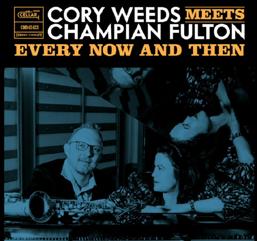
Now and Then.” She has the keyboard well covered, whether self-accompanying or playing full out as an instrumentalist. Let’s hope that we do not have to wait another five years for them to do this again. cellarlive.com
If the subject of swinging singers arises, at or near the top of any list would be Gabrielle Stravelli. She proves this once again on Beautiful Moons Ago (Big Modern Music – 003). Her combination of a deep jazz feeling with impeccable taste in songs is guaranteed to produce winning results. Her partners on this recording are pia-
nist Michael Kanan and bassist Pat
O’Leary. Listen to this lineup of songs, and you will see that Stravelli, and her partners dug deep for fine music that has stayed mostly under the radar.
The songs include “Did I Remember,” “June Night,” and “You Say You Care”, along with an original by Stravelli, Kanan and Jason Robinson, “So Far So Good”, and “Day Dream” paired with “You Stepped Out of a Dream”. This program gives Stravelli ample opportunity to explore a variety of tempi. It’s clear than Stravelli has not found a tempo that presents a problem for her. She has a voice that rests easily on your ears and the kind of creative approach to time that puts her in a special place. gabriellestravelli.com
Many NJ Jazz Societyt members will remember vocalist John Dokes from his appearances with the George Gee Big Band at some NJJS events. A few years ago, Dokes moved to Chicago,
so aside from occasional gigs in New York City with Gee’s band or smaller groups, he is no longer a presence on the New York scene. A trip to New York found him in a studio with a nonet from Gee’s band on a program of 10 songs arranged by Gee’s musical director David Gibson. The result is a treat titled Our Day (Swing Theory Entertainment). Dokes’s full baritone lends itself well to songs such as “Our Day Will Come,” “Moanin’,” and “Suddenly.” It is interesting to hear Dokes sing the Mark Murphy lyrics to Freddie Hubbard’s “Red Clay.” Gibson’s charts are well executed by the nonet, conducted by Gee. Anthony Nelson Jr. is on alto sax, Michael Hashim on tenor sax, Patience Higgins on baritone sax, Freddie Hendrix and Andy Gravish on trumpets, David Gibson on trombone, Steve Einerson on piano, Malik McLaurine on bass, and Chris Latona on drums. Welcome back John Dokes. johndokes.com
Continued from page 34
Discovered Many Unissued Jazz Recordings and Co-Founded Mosaic Records
Michael Cuscuna, who died April 20, 2024, in Stamford, CT, at the age of 75, was an archivist, historian, jazz producer, and writer. He was probably best known for two of many accomplishments: discovering unissued jazz recordings from the Blue Note vaults in 1975 and co-founding Mosaic Records with Charles Lourie in 1982.
In a statement issued after Cuscuna’s death, a spokesperson for Blue Note Records said, “Blue Note Records would not exist as it does today without the passion and dedication of Michael Cuscuna.”
Mosaic is a boutique label specializing in complete boxed sets of recordings by several legendary jazz artists such as Thelonious Monk, John
Coltrane, and Art Blakey. Cuscuna’s 1993 Complete Nat ‘King’ Cole Capitol Recordings won a Grammy Award for Best Historical Compilation.
Born September 20, 1948, in Stamford, Cuscuna began collecting 45 rpm records of rhythm & blues
artists when he was seven. He discovered jazz because he had a starter drum set, “and I got into drum records like Gene Krupa and Buddy Rich on Verve, then Max Roach and Art Blakey,” he said, in a January 2024 interview with DownBeat’s John McDonough. “When I started to hear the music around the drums, that’s when I got completely hooked. I went through Benny

Goodman, Dave Brubeck, and the MJQ, until I caught up to what was going on around me around 1960.”
By the time Cuscuna was a teenager, he was going to Birdland, which had a peanut gallery. “That’s when I heard Blakey and the Messengers, the Coltrane Quartet, and Miles,” he said. “They became my passion ... It’s the stuff that gets to you between about 12 and 25 that stays with you for life.” Earlier this year, DownBeat presented Cuscuna with a Lifetime Achievement Award.
While studying English at the University of Pennsylvania, Cuscuna began broadcasting at WXPN, moving from there to Philadelphia’s WMMR and then to WABC in New York. Later, while working as a DownBeat writer and reviewer, he won a Grammy for his liner notes contribution to the Columbia/Legacy album, Miles Davis Quintet, 1965-’68.
When the late Bruce Lundvall revived the Blue Note label in 1984, he hired Cuscuna as its Reissue Director. Cuscuna produced about 60 releases a year for the label. Michael J. West, writing on wrti.org the day after Cuscuna’s death, said Cuscuna searched “exhaustively through the label’s vast archives, producing hundreds of reissues and collections of newly discovered music.”
Ricky Riccardi, Louis Armstrong House Director of Research Collections, said, on Facebook, he was “devastated” by news of Cuscuna’s passing. “I know I’m not alone when I say that Mosaic Records changed my life, long before I got to co-produce a few sets from them. From the time I was in high school, they simply represented the gold standard in jazz reissues, and it remains that way to this day.”
Loren Schoenberg, Senior Scholar at the National Jazz Museum in
Harlem, also posted about Cuscuna on Facebook. “If you love jazz, you owe something to this man,” he said. “It’s hard to imagine any serious jazz collection that doesn’t have music that he had a hand in.”
Mosaic Producer Scott Wenzel said, “I can’t think of any better way to describe Michael than as my mentor. His guidance was immeasurable—filled with direction, leadership, knowledge, understanding ... Michael embraced my passion for jazz record collecting.”
The official announcement by Mosaic Records of Cuscuna’s death included this quote from him: “Jazz is still for me, the greatest music ever—it just ate its way into my soul, and it became a part of every fabric of my body ...”
Cuscuna is survived by his wife, Lisa; son, Max; daughter, Lauren; and two grandchildren, Nicolas and Penelope.
Known for Adding Layers of Electronic Effects onto His Instrument
Alto saxophonist Casey Benjamin, who passed away March 30, 2024, in Maryland at the age of 45, was a founding member of pianist Robert Glasper’s Experiment and also a regular member of vibraphonist Stefon Harris’ band, Blackout.

Benjamin was known for adding layers of electronic effects onto his instrument and also for playing the keytar (a keyboard instrument similar to a synthesizer) when onstage and not playing the saxophone.
Two Experiment recordings on which Benjamin performed won Grammy Awards: the 2012 Blue Note album, Black Radio for Best R&B Album; and the 2015 recording of the Stevie Wonder cover, “Jesus Children”, which won for Best Traditional R&B Performance. In 2012, The New York Times’ Nate Chinen described the Robert Glasper Experiment as a band that “specializes in deep, immersive grooves, nourished as much by hip-hop and
R&B as any known species of jazz.”
Glasper described Benjamin to Rolling Stone as “the epitome of what it means to be unique and one of a kind. The world lost a giant, and I lost a brother.”
Benjamin was born October 10, 1978, in Brooklyn. He grew up surrounded by Afro-Caribbean music and started playing piano at the age of eight, switching to saxophone about two years later. After graduating from the Fiorello H. LaGuardia High School of Music and Performing Arts, he studied at The New School, which is where he met Glasper.
Cause of death was a pulmonary thromboembolism. He is survived by his partner, Whitley Davis; his parents, Gentle and Julieta Benjamin; and siblings, Kevin and Nicole Benjamin and Cristina King.
“Lena
Horne and Sarah Vaughan All Rolled into One”
Vocalist Eleanor Collins was known as Canada’s “first lady of jazz”, but she was virtually unknown outside of that country. Collins, who died March 3, 2024, in Surrey, British Columbia, at the age of 104,
appeared regularly with jazz giants such as Dizzy Gillespie and fellow Canadian Oscar Peterson when they visited Vancouver, where she lived.
Born November 21, 1919, in Edmonton, Alberta, Collins began singing
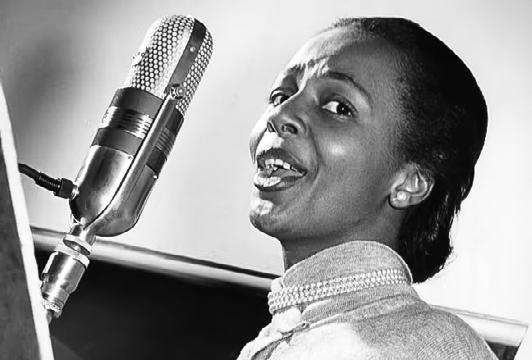
as a teenager and became popular after performing in Bamboula: A Day in the West Indies, a special on the Canadian Broadcasting Corporation about Caribbean music. Collins also had her own television show on CBC, making her the first woman and first Black person to host a program in Canada.
In a 2006 article in The Vancouver Sun, Canadian broadcaster Red Robinson described Collins as “Lena Horne and Sarah Vaughan all rolled into one.” But her lack of recognition outside of Canada was pretty much by design. “I never wanted a suitcase life,” she told The Sun in 1955. “I had offers, but one-bill stands and the night life in smoky clubs and halls didn’t fascinate, then or now.”
She is survived by three sons Rick, Barry, and Tom; a daughter, Judith; nine grandchildren; and 15 great-grandchildren.
THANK YOU and welcome to all who have recently joined or renewed their memberships. We can’t do what we do without you!
Your membership is vital to NJJS’s mission to promote and preserve America’s great art form— JAZZ!
Michael Woodland MAPLEWOOD, NJ
Marian Calabro HASBROUCK HEIGHTS
Peter Caldwell PINE BEACH, NJ
Dorothy Coviello MURRAY HILL, NJ
Beverly DeGraaf MORRISTOWN, NJ
Glenn Fogarty CLARK, NJ
Brian Hochstadt MORRISTOWN, NJ
W. Ronald Lilly FANWOOD, NJ
Basil Vorolieff HASKELL, NJ
Kevin Ward BERKELEY HEIGHTS, NJ